各种时态的主动被动语态结构表
被动语态各种时态构成表

被动语态各种时态构成表:TENSE被动语态be\do\does am\is\are+donewill+do will be +doneam\is\are+doing am\is\are+being+d①was\were was\were+done现在完成have\has+done have\has+been+dohad+done had+been+donewas\were+doing was\were+being+d 情态动词情态动词+do情态动词一般现、过用be done, be有人称、时、数变例:1、主动:The children gave the foreign guests a warm welcome. 被动:The foreign guests were given a warm welcome by the children. 孩子们热烈地欢迎外宾。
2、主动:People regard him as brilliant. 被动:He is regarded as brilliant by people.人们认为他很有才华。
1、边境发生严重列车事故,二人死亡,十二人受伤。
There was a serious train accident near the border. Two people were killed and twelve were injured.2、直言不讳的人才是真正诚实的人。
A person who is truly honest is called a straight arrow.3、有人给讲演者递上来一张纸条。
A note was passed up to the speaker.4、John被选为班长而代替了亨利。
John was elected president of the class instead of Harry.5、这位战士牺牲了,然而列车得救了。
(完整word版)八种时态主动语态被动语态
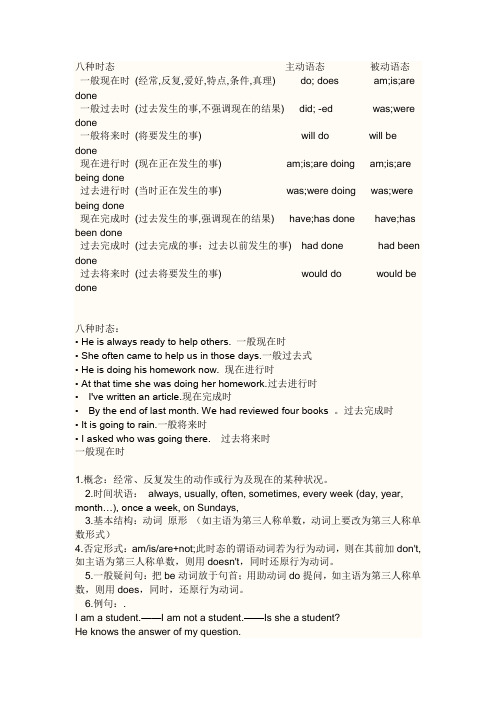
八种时态主动语态被动语态一般现在时(经常,反复,爱好,特点,条件,真理) do; does am;is;are done一般过去时(过去发生的事,不强调现在的结果) did; -ed was;were done一般将来时(将要发生的事) will do will be done现在进行时(现在正在发生的事) am;is;are doing am;is;are being done过去进行时(当时正在发生的事) was;were doing was;were being done现在完成时(过去发生的事,强调现在的结果) have;has done have;has been done过去完成时(过去完成的事;过去以前发生的事) had done had been done过去将来时(过去将要发生的事) would do would be done八种时态:• He is always ready to help others. 一般现在时• She often came to help us in those days.一般过去式• He is doing his homework now. 现在进行时• At that time she was doing her homework.过去进行时• I've written an article.现在完成时• By the end of last month. We had reviewed four books 。
过去完成时• It is going to rain.一般将来时• I asked who was going there. 过去将来时一般现在时1.概念:经常、反复发生的动作或行为及现在的某种状况。
2.时间状语:always, usually, often, sometimes, every week (day, year, month…), once a week, on Sundays,3.基本结构:动词原形(如主语为第三人称单数,动词上要改为第三人称单数形式)4.否定形式:am/is/are+not;此时态的谓语动词若为行为动词,则在其前加don't,如主语为第三人称单数,则用doesn't,同时还原行为动词。
(完整word版)八种时态主动语态被动语态

八种时态主动语态被动语态一般现在时(经常,反复,爱好,特点,条件,真理) do; does am;is;are done一般过去时(过去发生的事,不强调现在的结果) did; -ed was;were done一般将来时(将要发生的事) will do will be done现在进行时(现在正在发生的事) am;is;are doing am;is;are being done过去进行时(当时正在发生的事) was;were doing was;were being done现在完成时(过去发生的事,强调现在的结果) have;has done have;has been done过去完成时(过去完成的事;过去以前发生的事) had done had been done过去将来时(过去将要发生的事) would do would be done八种时态:• He is always ready to help others. 一般现在时• She often came to help us in those days.一般过去式• He is doing his homework now. 现在进行时• At that time she was doing her homework.过去进行时• I've written an article.现在完成时• By the end of last month. We had reviewed four books 。
过去完成时• It is going to rain.一般将来时• I asked who was going there. 过去将来时一般现在时1.概念:经常、反复发生的动作或行为及现在的某种状况。
2.时间状语:always, usually, often, sometimes, every week (day, year, month…), once a week, on Sundays,3.基本结构:动词原形(如主语为第三人称单数,动词上要改为第三人称单数形式)4.否定形式:am/is/are+not;此时态的谓语动词若为行为动词,则在其前加don't,如主语为第三人称单数,则用doesn't,同时还原行为动词。
各种时态的主动语态和被动语态谓语结构对照表

各种时态的主动语态和被动语态谓语结构对照表时态主动语态被动语态am/is/are+过去分词was/were+过去分词一般现在时do/does一般过去时did一般将来时will/begoingto+动词will/begoingto+be+过去分原形词过去将来时would+动词原形would+be+过去分词现在进行时am/is/are+现在分词am/is/are+being+过去分词过去进行时was/were+现在分词was/were+being+过去分词现在完成时have/has+过去分词过去完成时had+过去分词have/has+been+过去分词had+been+过去分词含情态动词情态动词+动词原形情态动词+be+过去分词使役动词和感观动词主被动语态对照表主动语态使make sb do sth役动have sb do sth词let sb do sthsee sb do sth感观watch sb do sth动词hear sb do sthnotice sb do sth被动语态sb be made to do sthsb be had to do sthsb be let to do sthsb be seen to do sthsb be watched to do sthsb be heard to do sthsb be noticed to do sth①Lily writes many letters every day.(主动)②Th ey visited this farm last year.(主动)③We have learned 3000 English words so far.(主动)Fill in the blanks with the Passive Voice1、Tea_______(grow) in Fujian.2、Chinese__________(speak) in China.3、The bed__________(use) for sleeping.4、Ourclassroom _________(clean) everyday.5、The cars__________(make) in Beijing.6.We will build a new lab.A new lab ____ ____ _____.(主动变被动)7. The blackboard was ________ (look) carefully by the students.8 The ship model ____ be ____ (make)in two days.1.An exhibition of paintings ____ at the museum next week.A.are to be heldB. is to be held C. are holding D.will be held2. I’m sorry,sir.Your recorder isn’t ready yet.It ____ in the factory.A.is being repairedB is repaired C. has been repaired Dhasn’t been repaired3. A lot of people in China can speak English now .(同上)English ______ ____ ______ by a lot of people in China now.4. I have learned English for about two years.(同上)English ______ ______ ______ for about two years.5. They will publish these story-books next month.(同上)These story-books _____ _____ _____ next month.6.Peoplethereplantedmanytreeslastyear.Trees__________by people there last year. (青岛市中考题)7. Theygrowvegetables on the farm.The vegetables_____________on the farm(上海市中考题)8.Our school _________in 2002.(开办)9.The young trees must____ ____ ______well.(照顾)10. _____ this building_________(建成)last year?11.The book _____ _______(写)by him last year.12. The bridge _______ _______(不建造)in1989..13.The 29th Olympic Games will____ ______(举行) in UK in 2012.14. He gives me a ring.I _____________ a ring ____ him.15. Jack made his little sister cry again.His sister _________ ____ cry again.1.被动语态练习() 1 The People's Republic of China __ on October 1, 1949.A. foundB. was foundedC. is foundedD. was found() 2 English ____ in Canada.A. speaksB. are spokenC. is speakingD. is spoken() 3 This English song___ by the girls after class.A. often singsB. often sangC. is often sangD. is often sung() 4 This kind of car ___ in Japan.A, makes B. made C. is making D. is made() 5 New computers ___ all over the world.A. is usedB. are usingC. are usedD. have used() 6 His new book___ next month.A. will be publishedB. is publishingC. is being publishedD. has been published()7 The sports meet ___ be held until next week.A. didn'tB. won'tC. isn'tD. doesn't。
八大时态的被动语态结构

八大时态的被动语态结构
以下是八大时态的被动语态结构:
1. 现在时被动语态(Present Simple Passive):主语 + am/is/are + 过去分词。
2. 过去时被动语态(Past Simple Passive):主语 + was/were + 过去分词。
3. 将来时被动语态(Future Simple Passive):主语+ will be + 过去分词。
4. 现在进行时被动语态(Present Continuous Passive):主语 + am/is/are being + 过去分词。
5. 过去进行时被动语态(Past Continuous Passive):
主语 + was/were being + 过去分词。
6. 现在完成时被动语态(Present Perfect Passive):
主语 + has/have been + 过去分词。
7. 过去完成时被动语态(Past Perfect Passive):主语 + had been + 过去分词。
8. 将来完成时被动语态(Future Perfect Passive):主语 + will have been + 过去分词。
各种时态的主动、被动语态结构表
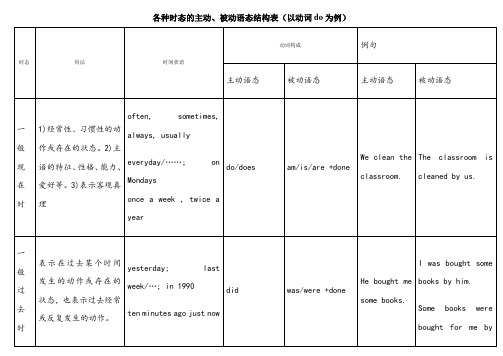
was/were+done
Hebought me some books.
I was bought some booksby him.
Some books were bought for me byhim.
现在进行
1)表示此时此刻或现阶段正在进行或持续的动作
now, these days等或当句中含有look, listen之类的暗示词时
am/is/are+doing
am/is/are+being+done
She is watering the flowers.
The flowers are being made by her.
过去进行
表示在过去某一时刻或过erday, at that time, then, at ten yesterday, from 7:00 to 9:00 last night
had+done
had been+done
They had told me the newsby 9 o’clock yesterday.
I had been told the news by 9 o’clock yesterday.
The news had been told to me by 9 o’clock yesterday.
was/were+doing
was/were+being+done
I wasplanting treesthis time yesterday .
Trees were being planted by me this time yesterday.
一般将来时
英语各时态的主动句和被动句

一般将来时(Simple Future):主动语态:明天我将会见我的朋友。
(I will meet my friend tomorrow.)被动语态:我的朋友将被我明天见到。
(My friend will be met by me tomorrow.)主动语态:下个月我将搬到一个新的城市。
(I will move to a new city next month.)被动语态:一个新的城市将被我下个月搬到。
(A new city will be moved to by me next month.)主动语态:明年我将开始学习弹钢琴。
(I will start learning to play the piano next year.)被动语态:学习弹钢琴将被我明年开始。
(Learning to play the piano will be started by me next year.)现在进行时(Present Continuous):主动语态:我正在看电视节目。
(I am watching a TV show.)被动语态:电视节目正在被我观看。
(A TV show is being watched by me.)主动语态:他们正在制定新的计划。
(They are making new plans.)被动语态:新的计划正在被他们制定。
(New plans are being made by them.)主动语态:我们正在等待朋友的到来。
(We are waiting for our friend's arrival.)被动语态:朋友的到来正在被我们等待。
(Our friend's arrival is being waited for by us.)现在完成时(Present Perfect):主动语态:我已经完成了我的工作报告。
(I have finished my work report.)被动语态:我的工作报告已经被我完成了。
各种时态的主动语态和被动语态
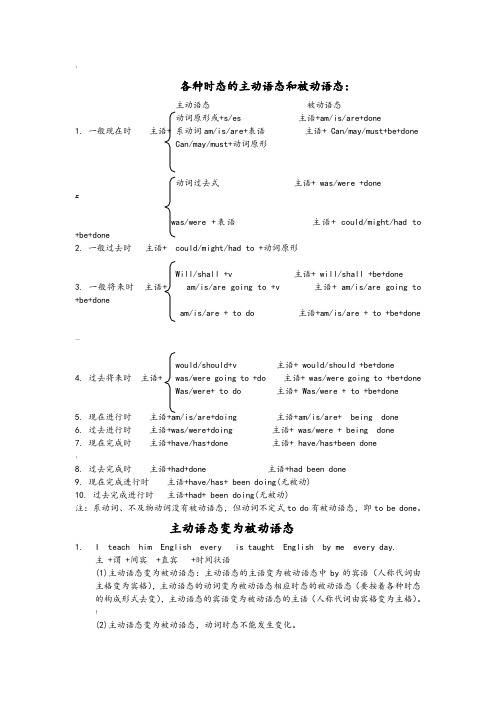
;各种时态的主动语态和被动语态:主动语态被动语态动词原形或+s/es 主语+am/is/are+done1. 一般现在时主语+ 系动词am/is/are+表语主语+ Can/may/must+be+doneCan/may/must+动词原形动词过去式主语+ was/were +done&was/were +表语主语+ could/might/had to+be+done2. 一般过去时主语+ could/might/had to +动词原形Will/shall +v 主语+ will/shall +be+done3. 一般将来时主语+ am/is/are going to +v 主语+ am/is/are going to+be+doneam/is/are + to do 主语+am/is/are + to +be+done—would/should+v 主语+ would/should +be+done4. 过去将来时主语+ was/were going to +do 主语+ was/were going to +be+doneWas/were+ to do 主语+ Was/were + to +be+done5. 现在进行时主语主语+am/is/are+ being done6. 过去进行时主语+was/were+doing 主语+ was/were + being done7. 现在完成时主语+have/has+done 主语+ have/has+been done;8. 过去完成时主语+had+done 主语+had been done9. 现在完成进行时主语+have/has+ been doing(无被动)10. 过去完成进行时主语+had+ been doing(无被动)注:系动词、不及物动词没有被动语态,但动词不定式to do有被动语态,即to be done。
主动语态变为被动语态1.I teach him English every is taught English by me every day.主 +谓 +间宾 +直宾 +时间状语(1)主动语态变为被动语态:主动语态的主语变为被动语态中by的宾语(人称代词由主格变为宾格),主动语态的动词变为被动语态相应时态的被动语态(要按着各种时态的构成形式去变),主动语态的宾语变为被动语态的主语(人称代词由宾格变为主格)。
(完整版)专题10 动词的被动语态

专题十动词的被动语态网络知识清单主动语态被动语态动词的语态主动形式表被动意义被动形式表主动意义常考点清单一被动语态的构成及用法一、被动语态的构成1.被动语态的基本结构为:be + 动词的过去分词二、在被动语态中,主语是动作的承受者,主要用于下列几种情况:1.不知道动作的执行者是谁。
如:This watch is made in China。
2。
没有必要指出动作的执行者是谁。
如:More trees must be planted every year.3. 需要强调或突出动作的承受者时。
如:Chinese is spoken by more and more people in the world.4。
句子的主语不是人.如:Many houses were washed away by the flood。
常考点清单二主动鱼台和被动语态的转换一、主动语态变为被动语态1。
要将主动句里的宾语变为被动句中的主语,若主动句中的宾语时人称代词,要将宾语变成主语。
2. 把主动句中的主语变为被动句中的宾语,主格代词变成宾格代词,并由by引导。
3. 谓语动词变成相应的被动形式.主语语态:动作执行者 + 谓语动词主动形式 + 动作承受者被动语态:动作承受者 + 谓语动词被动形式 + 动作执行者如:We asked him to sing an English song. (变为被动语态)He was asked to sing an English song by us.二、带双宾语的谓语动词变为被动语态谓语动词带双宾语时,既可以将间接宾语转化为主语,也可以将直接宾语转化为主语。
若将间接宾语转化为主语,则保留直接宾语;若将直接宾语转化为主语则保留间接宾语,且在被保留的间接宾语前加上介词to或for.如:She gave me a book. (变为被动语态)→I was given a book by her。
(间接宾语me改为了主语)A book was given to me by her。
八种时态的结构和被动语态

八种时态的结构和被动语态一、一般现在时态一般现在时态表示经常性的动作或状态。
在句子中,主语加上动词的原形即可构成一般现在时态的句子。
例句:Dogs bark.(狗叫。
)被动语态:由“be+过去分词”构成。
例句:The cake is baked by my mother.(蛋糕是我妈妈烤的。
)二、一般过去时态一般过去时态表示过去某个时间发生的动作或存在的状态。
在句子中,主语加上动词的过去式即可构成一般过去时态的句子。
例句:She ate an apple yesterday.(她昨天吃了一个苹果。
)被动语态:由“was/were+过去分词”构成。
例句:The book was written by Mark Twain.(这本书是马克·吐温写的。
)三、一般将来时态一般将来时态表示将要发生的动作或存在的状态。
在句子中,主语加上助动词“will”或“shall”,再加上动词的原形即可构成一般将来时态的句子。
例句:I will visit my grandparents next week.(我下周会去看望我的祖父母。
)被动语态:由“wil l be+过去分词”或“is/am/are going to be+过去分词”构成。
例句:The letter will be delivered by the postman.(这封信将由邮递员投递。
)四、现在进行时态现在进行时态表示现在正在进行的动作。
在句子中,主语加上“be”动词的现在分词形式,再加上动词的原形即可构成现在进行时态的句子。
例句:She is watching TV now.(她正在看电视。
)被动语态:由“am/is/are being+过去分词”构成。
例句:The house is being cleaned by the maid.(房子正在被女仆打扫。
)五、过去进行时态过去进行时态表示过去某个时间正在进行的动作。
在句子中,主语加上“was/were”动词的现在分词形式,再加上动词的原形即可构成过去进行时态的句子。
8种时态的被动语态

动词的语态:主动语态和被动语态被动语态的基本结构:Be + done(过去分词)1、一般现在时:(主动语态)I help you.发出者动词承受者变为被动语态:Do——am/is/are doneYou are helped by me.承受者谓语发出者2、一般过去时的被动:did——was/were done(I helped you.-每个例子可让学生自己先尝试变被动,再给答案)3、一般将来时的被动:Will do——will be done(I will help you.-)4、现在进行时的被动:Am/is/are doing ——Am/is/are being done(I am helping you.-)5、过去进行时的被动:Was/were doing——Was/were being done(I was helping you.-)6、现在完成时的被动:Have done——have been done (I have helped you.-)7、过去完成时的被动:Had done——had been done (I had helped you.-)8、过去将来时的被动:Would do ——would be done (I would help you.-)答案:2、You were helped by me.3、You will be helped by me.4、You are being helped by me.5、You were being helped by me.6、You have been helped by me.7、You had been helped by me.8、You would be helped by me.。
六大主动时态和被动语态的结构
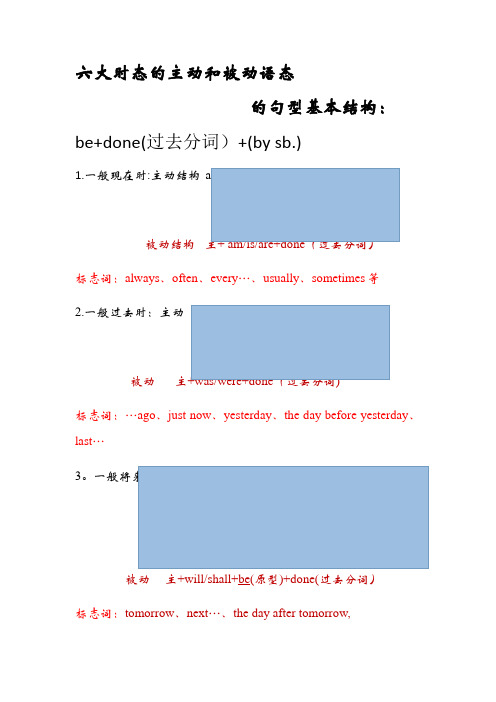
b。主+v.过去式
被动 主+was/were+done(过去分词)
标志词:…ago、just now、yesterday、the day before yesterday、last…
3。一般将来时:主动 主+will/shall/+ v.原
主+ (am/is/are)going to+v。原
主+(am/is/are)+Ving(备注:短暂性动词的ing形式)
被动 主+will/shall+be(原型)+done(过去分词)
标志词:tomorrow、next…、the day after tomorrow,
4。现在进行时:主动 主+am/is/are+V—ing
被动 主+am/is/aat the moment
5。过去进行时:主动 主+was/were+V.ing
被动 主+was/were being done(过去分词)
标志词:at that time,具体的时间点+过去的时间
六大时态的主动和被动语态
的句型基本结构:
be+done(过去分词)+(by sb.)
1.一般现在时:主动结构 a。 主+be(am/is/are)
b. 主+v.原或v。三单
被动结构 主+ am/is/are+done(过去分词)
标志词:always、often、every…、usually、sometimes等
6。现在完成时:主动 主+have/has done(过去分词)
被动语态在各时态中的变化

被动语态在各时态中的变化被动语态是英语中的一种语法结构,用于表示主语是动作的接受者,而不是执行者。
在不同的时态下,被动语态的构造和变化会有所不同。
本文将就被动语态在各时态中的变化进行详细讨论。
一、一般现在时的被动语态一般现在时的被动语态由助动词“am/is/are”+过去分词构成。
它被用于表示动作在现在被执行或经常被执行的情况下。
例如:主动语态:They deliver the products.(他们交付产品。
)被动语态:The products are delivered by them.(产品被他们交付。
)二、一般过去时的被动语态一般过去时的被动语态由助动词“was/were”+过去分词构成。
它用于表示过去某一事件或动作的被动形式。
例如:主动语态:He repaired the car.(他修理了汽车。
)被动语态:The car was repaired by him.(汽车被他修理了。
)三、一般将来时的被动语态一般将来时的被动语态由助动词“will be”+过去分词构成。
它表示将来某一事件或动作的被动形式。
例如:主动语态:They will complete the project.(他们将完成这个项目。
)被动语态:The project will be completed by them.(这个项目将被他们完成。
)四、现在进行时的被动语态现在进行时的被动语态由助动词“am/is/are”+being+过去分词构成。
它表示现在某一事件或动作正在被执行。
例如:主动语态:She is writing the report.(她正在写报告。
)被动语态:The report is being written by her.(报告正在被她写。
)五、过去进行时的被动语态过去进行时的被动语态由助动词“was/were”+being+过去分词构成。
它表示过去某一事件或动作正在被执行。
例如:主动语态:They were building the house.(他们在建房子。
被动语态各种时态构成表

被动语态各种时态构成表:TENSE 主动语态被动语态一般现在时be\do\does am\is\are+done一般将来时will+do will be +done现在进行时am\is\are+doing am\is\are+being+done一般过去时①was\were ②did was\were+done现在完成时have\has+done have\has+been+done过去完成时had+done had+been+done过去进行时was\were+doing was\were+being+done情态动词情态动词+do 情态动词+be+done一般现、过用be done, be有人称、时、数变例:1、主动:The children gave the foreign guests a warm welcome.被动:The foreign guests were given a warm welcome by the children.孩子们热烈地欢迎外宾。
2、主动:People regard him as brilliant.被动:He is regarded as brilliant by people.人们认为他很有才华。
1、边境发生严重列车事故,二人死亡,十二人受伤。
There was a serious train accident near the border. Two people were killed and twelve were injured.2、直言不讳的人才是真正诚实的人。
A person who is truly honest is called a straight arrow.3、有人给讲演者递上来一张纸条。
A note was passed up to the speaker.4、John被选为班长而代替了亨利。
John was elected president of the class instead of Harry.5、这位战士牺牲了,然而列车得救了。
各种时态主动、被动语态结构表格

组成例句用法状主被主被一般1) 常性、性的作或存在的often, sometimes, always, usuallyWe clean the The classroom is cleaned by在状。
2) 主的特点、性格、能力、everyday/ ⋯⋯ ;on Mondays do/does am/is/are +done.好等。
3) 表示客真谛once a week , twice a yearI was bought some books by 一般表示在去某个生的作或yesterday; last w eek/ ⋯ ; in 1990He bought me some him.去存在的状,也表示去常或反did was/were +doneten minutes ago just now books.Some books were bought for me 复生的作。
by him.在1) 表示此现在或段正在行now, these days 等或当句中含有 look,She is watering the The flowers are being made byam/is/are +doing am/is/are + being + done行或持的作listen 之的示意flowers.her.this time yesterday, at that time,I was planting trees去表示在去某一刻或去某一Trees were being planted by me then, at ten yesterday, from7:00 to was/were +doing was/were + being +done this time行段正在行的作this time yesterday.9:00 last night yesterday .will/shall + do will/shall be + done一般tomorrow; next week We will discuss this 表示未来要生的作或存在的状am/is/are going to +am/is/are going to be +This question will be 将来in a few days question in classdo done discussed in class tomorrow.in 2021tomorrow.am/is/are + doing am/is/are being done去表示从去某一看将要生的would/should + do would/should be + done He said he wouldHe said the work would be 将来作或存在的状,常用在从was/were going to+ do was/were going to be +done finish the work thefinished the next day.句中was/were + doing was/were being + done next day.1〕表示去生的作或事情在在的影响和生的果. 它的, yet, ever, never, just, before等They have made theThe boy has been made to stop 完成是去的作同在的系。
八种时态 主动语态 被动语态
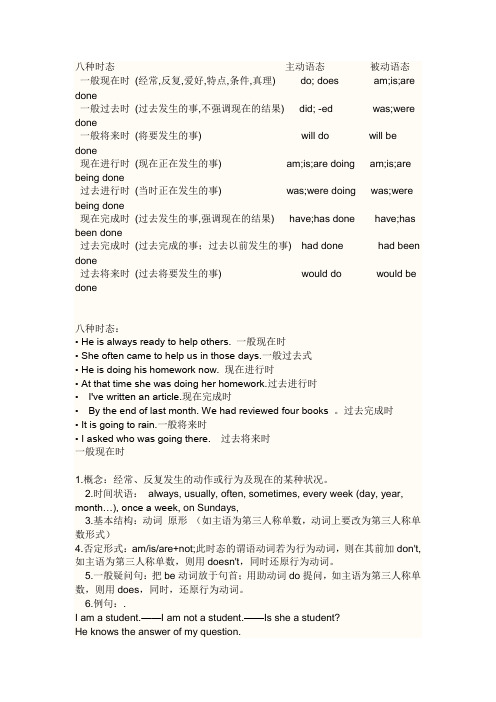
八种时态主动语态被动语态一般现在时(经常,反复,爱好,特点,条件,真理) do; does am;is;are done一般过去时(过去发生的事,不强调现在的结果) did; -ed was;were done一般将来时(将要发生的事) will do will be done现在进行时(现在正在发生的事) am;is;are doing am;is;are being done过去进行时(当时正在发生的事) was;were doing was;were being done现在完成时(过去发生的事,强调现在的结果) have;has done have;has been done过去完成时(过去完成的事;过去以前发生的事) had done had been done过去将来时(过去将要发生的事) would do would be done八种时态:• He is always ready to help others. 一般现在时• She often came to help us in those days.一般过去式• He is doing his homework now. 现在进行时• At that time she was doing her homework.过去进行时• I've written an article.现在完成时• By the end of last month. We had reviewed four books 。
过去完成时• It is going to rain.一般将来时• I asked who was going there. 过去将来时一般现在时1.概念:经常、反复发生的动作或行为及现在的某种状况。
2.时间状语:always, usually, often, sometimes, every week (day, year, month…), once a week, on Sundays,3.基本结构:动词原形(如主语为第三人称单数,动词上要改为第三人称单数形式)4.否定形式:am/is/are+not;此时态的谓语动词若为行为动词,则在其前加don't,如主语为第三人称单数,则用doesn't,同时还原行为动词。
- 1、下载文档前请自行甄别文档内容的完整性,平台不提供额外的编辑、内容补充、找答案等附加服务。
- 2、"仅部分预览"的文档,不可在线预览部分如存在完整性等问题,可反馈申请退款(可完整预览的文档不适用该条件!)。
- 3、如文档侵犯您的权益,请联系客服反馈,我们会尽快为您处理(人工客服工作时间:9:00-18:30)。
Hesaidhewouldfinishtheworktห้องสมุดไป่ตู้enextday.
Hesaidtheworkwouldbefinishedthenextday.
现在完成时
1)表示过去发生的动作或事情对现在的影响和产生的结果.它强调的是过去的动作同现在的联系。2)表示一个从过去开始,一直持续到现在,有可能继续下去的动作或状态.
do/does
am/is/are+done
Wecleantheclassroom.
Theclassroomiscleanedbyus.
一般过去时
表示在过去某个时间发生的动作或存在的状态,也表示过去经常或反复发生的动作。
yesterday;lastweek/…;in1990
tenminutesagojustnow
had+done
hadbeen+done
Theyhadtoldmethenewsby9o’clockyesterday.
Ihadbeentoldthenewsby9o’clockyesterday.
Thenewshadbeentoldtomeby9o’clockyesterday.
含有情态动词
can/may/mustdo
,yet,ever,never,just,before等
2.和for或since引导的时间状语连用.
have/has+done
have/hasbeen+done
Theyhavemadetheboystopcryingalready.
Theboyhasbeenmadetostopcryingalready.
过去完成时
1)过去完成时动词表示过去某一时间或某一动作之前完成的动作或状态。
2)从过去某一时间开始持续到过去另一时间的动作或状态。
1)与bythen,by9o’clock,bytheendof,bythetime…,before+过去的时间构成的短语连用。2)过去完成时和already,just,ever,yet等连用。3)与when,before,after,assoonas等引导时间状语的从句连用,强调动作发生的时间前后
can/may/mustbedone
Wemusttakegoodcareoftheold.
Theoldmustbetakegoodcareofbyus.
各种时态的主动、被动语态结构表(以动词do为例)
时态
用法
时间状语
动词构成
例句
主动语态
被动语态
主动语态
被动语态
一般现在时
1)经常性、习惯性的动作或存在的状态。2)主语的特征、性格、能力、爱好等。3)表示客观真理
often,sometimes,always,usually
everyday/……;onMondaysonceaweek,twiceayear
did
was/were+done
Heboughtmesomebooks.
Iwasboughtsomebooksbyhim.
Somebookswereboughtformebyhim.
现在进行
1)表示此时此刻或现阶段正在进行或持续的动作
now,thesedays等或当句中含有look,listen之类的暗示词时
Thisquestionwillbediscussedinclasstomorrow.
过去将来时
表示从过去某一时间看将要发生的动作或存在的状态,常用在宾语从句中
would/should+do
was/weregoingto+do
was/were+doing
would/shouldbe+done
was/weregoingtobe+done
in2020
will/shall+do
am/is/aregoingto+do
am/is/are+doing
will/shallbe+done
am/is/aregoingtobe+done
am/is/arebeingdone
Wewilldiscussthisquestioninclasstomorrow.
am/is/are+doing
am/is/are+being+done
Sheiswateringtheflowers.
Theflowersarebeingmadebyher.
过去进行
表示在过去某一时刻或过去某一阶段正在进行的动作
thistimeyesterday,atthattime,then,attenyesterday,from7:00to9:00lastnight
was/were+doing
was/were+being+done
Iwasplantingtreesthistimeyesterday.
Treeswerebeingplantedbymethistimeyesterday.
一般将来时
表示将来要发生的动作或存在的状态
tomorrow;nextweek
inafewdays
